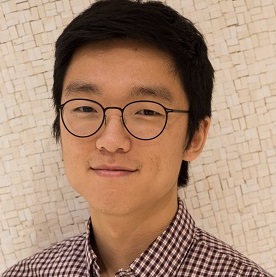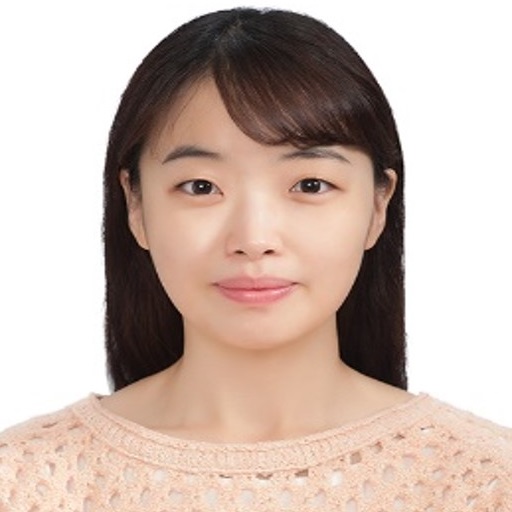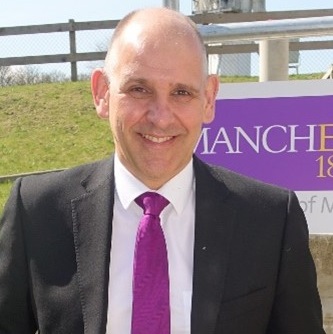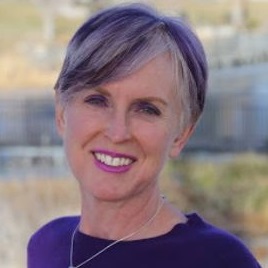STE Highlights, August 2022
Awards and Recognition
Earth and Environmental Sciences
New review explores advances and frontiers in fractured rock science
Theoretical
ClusterVQE algorithm offers quantum parallel approach for quantum chemistry simulations
Breakthrough accuracy in semi-empirical quantum chemistry via deep learning
Awards and Recognition
DOE postdoctoral recognition earned by MPA researchers
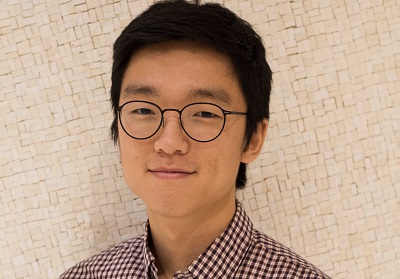
ChungHyuk Lee
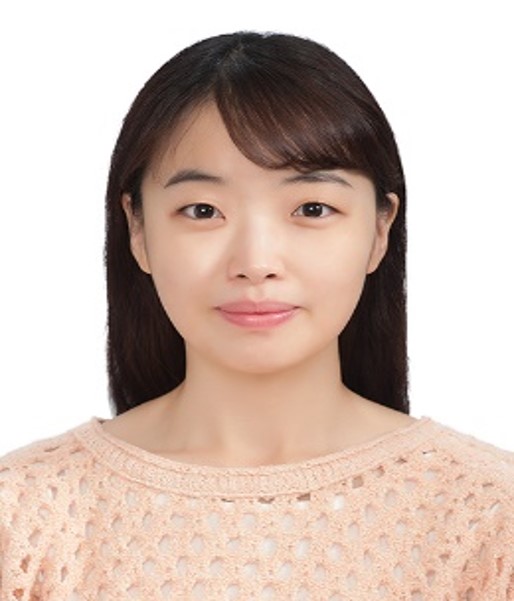
Katie Lim
ChungHyuk Lee and Katie Lim were recognized for their Los Alamos postdoctoral work in the Hydrogen and Fuel Cell Technologies Office Postdoctoral Recognition Award program for 2022. The annual award recognizes “outstanding contributions in the research, development, and demonstration of hydrogen and fuel cell technology.”
ChungHyuk Lee
Lee was honored for his work during a postdoctoral fellowship on the Fuel Cells and Electrochemical Sensors team within the Materials Synthesis and Integrated Devices group (MPA-11), researching high-performing and durable electrodes for proton-exchange membrane fuel cells (also the topic of his award presentation). The Hydrogen and Fuel Cells Technology Office notes that “Lee has contributed to proton exchange membrane fuel cell RD&D through fabrication of electrodes with controlled crack density; design of grooved electrodes with enhanced performance; and elucidation of the effect of Co2+ contamination in the electrode ionomer.” Lee’s research focused on designing and developing high-performing fuel cell cathodes by tuning their porosity, with the goal of yielding important insight into the transport properties of porous electrodes, guiding the next generation of electrode designs for electrochemical systems. Lee has published 25 peer-reviewed journal articles.While at the Laboratory, Lee was the recipient of a Laboratory Director’s Postdoctoral Fellowship and a Natural Sciences and Engineering Research Council of Canada Postdoctoral Fellowship. He was mentored in his postdoctoral fellowship by Rangachary Mukundan and Jacob S. Spendelow (both MPA-11). Lee, who earned his doctoral degree in mechanical engineering from the University of Toronto, is now an assistant professor in the department of chemical engineering at Toronto Metropolitan University (Canada).
Katie Lim
Lim, post-doctoral research associate in the Fuel Cells and Electrochemical Sensors team within MPA-11, received honorable mention recognition for her work developing membrane electrode assembly for high temperature polymer electrolyte membrane fuel cells, one of the most promising technologies to realize the electrification of heavy-duty vehicles. With mentoring from Yu Seung Kim and Sandip Maurya (both MPA-11), Lim’s work developing efficient and stable membrane electrode assemblies with protonated phosphonic acid electrodes and fluorinated electrodes is a necessary contribution in achieving state-of-the-art high-temperature polymer electrolyte membrane fuel cell systems.
Lim earned her doctoral degree from Yonsei University in 2018. She has published 12 papers in peer-reviewed journals in the electrochemical energy conversion/storage field.
Bourne selected as 2023 LANSCE Rosen Scholar
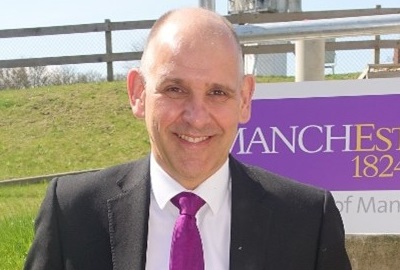
Neil Bourne
Neil Bourne, inaugural director and professor of matter in extreme environments for the University of Manchester at Harwell, has been selected as the 2023 LANSCE Rosen Scholar. The Rosen Scholarship is reserved for individuals recognized as scientific leaders in a field of research currently performed at LANSCE and who exemplify the innovative and visionary qualities of Louis Rosen.
Bourne established and launched the University of Manchester at Harwell, uniting the University of Manchester, the Diamond Light Source, the Science and Technology Facilities Council, and the Research Complex at Harwell, a portal to the wider Harwell Campus. He also is the inaugural director of The Thomas Ashton Institute, partnering the University and the Health and Safety Executive, that aims to deliver research, learning, and regulatory insight to enable a better working world. His primary research lies in the behavior of materials and structures in demanding and extreme environments which align to the fields of defense science. While at LANSCE, Professor Bourne will work to advance extreme science, researching the transition in behavior in extreme states of matter, the study of critical thresholds in primary physics enhancing national facility science, and filling critical gaps.
Bourne obtained his doctoral and doctor of science degree at the University of Cambridge. He has published nearly 400 papers, commentaries and reviews in publications from the British Journal of Surgery to Nature Physics, and a book uniting the physical and engineering science of matter in extremes. He has been elected a fellow of the American Physical Society and chaired its international division devoted to extreme physics. He also holds fellowships from the Institute of Physics, the Institute of Materials, is a Chartered Engineer and a Principal Fellow of the Higher Education Academy, championing experiential pedagogy across his core areas of work. He has received many awards including the Paul A. Siple Memorial Medal for Achievement. He is an editor of the Journal of Dynamic Behaviour of Materials and is in the process of founding a new journal, Safety in Extreme Environments: People, Risk and Security.
The Rosen Scholarship is a fellowship created to honor the memory of Louis Rosen — his accomplishments, hard work and affection for the broad range of science performed at LANSCE. Louis Rosen’s outstanding leadership and scientific career at Los Alamos covered more than six decades and included conception of the Los Alamos Meson Physics Facility in 1960, a vision that culminated with the facility’s commissioning in 1972.
Laboratory researcher chairs international leadership conference

Heather Quinn
Laboratory researcher Heather Quinn recently served as chair of the IEEE Women in Engineering International Leadership Conference, leading a committee charged with organizing, managing and hosting the event. The mission of the annual conference is “to inspire, engage and advance women in technology, whether in industry, academia or government.” Held in San Diego in June, the conference drew participants from more than 50 countries.
Quinn, team leader for the Radiation Effects and Reliability team within the Space Data Science and Systems group (ISR-3), had responsibilities included moderating the talks from among the more than 120 speakers and interviewing presenters, in addition to the pre-conference planning and organizing. Keynote speakers included an array of industry leaders and innovators. Conference attendees represented more than 400 industries.
A senior member of the IEEE, Quinn is an associate editor of the IEEE Transactions on Nuclear Science. She has been chair of the IEEE Los Alamos and Northern New Mexico section, and has been the Region 6 Women in Engineering chair since 2019. Quinn will also chair the 2022 WIE ILC and the IEEE’s 2024 Nuclear and Space Radiation Effects Conference.
Quinn began as a postdoctoral fellow at Los Alamos National Laboratory in 2004, joining the Laboratory as a member of the technical staff in 2006. Her research has focused on software/hardware co-design issues with integrating field programmable gate arrays into traditional computation systems; fault-tolerant, space-based field programmable gate array computation; radiation effects in microprocessors; and radiation testing of next-generation electronics. Quinn received a bachelor’s degree in mathematics and physics from Knox College in 1992, and master’s and doctoral degrees in electrical engineering from Northeastern University in 2000 and 2004, respectively.
People interested in joining the IEEE should contact Christian Pantea, chair of the IEEE Los Alamos Northern New Mexico section.
Los Alamos-Texas A&M Collaborative Research Program awards announced
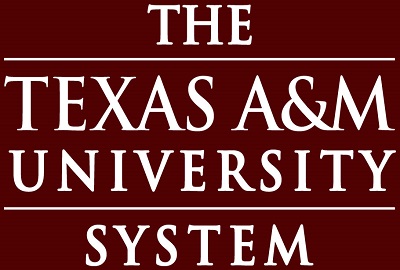
Texas A&M University System
Awardees have been announced for the 2022-2023 edition of the Texas A&M System National Laboratories Office Collaborative Research Program with Los Alamos National Laboratory. The Collaborative Research Program comprises development fellowships, research projects and exploration mini-grants. For 2022-2023, seven development fellowships and six research projects have been awarded.
Development fellowships are designed for researchers who have the skills, knowledge and interest to develop long-term collaborative ties with Los Alamos researchers. Development fellowship projects for 2022-2023 range from shock-accelerated particle simulation, to understanding issues with metal-halide perovskites, to developing a flight path for university radiation-effects research at LANSCE, and more. Los Alamos research collaborators come from a range of areas at the Laboratory, from computer, computational and statistical sciences; to physics; to the Center for Integrated Nanotechnologies, among others.
Research projects encompass a broad range of research and development activities. The projects are designed for Texas A&M University System researchers who have established ties with Los Alamos collaborators and identified research topics suitable for joint effort and funding, typically for four years. Selection as a Collaborative Research Program project provides funding for a graduate student employed for the life of the project, spending summers engaged with the project in Los Alamos. This year’s projects range from materials research, to neonicotinoid exposure among wild birds, to dark matter and gamma ray astrophysics. Los Alamos collaborators on the six projects funded include members of the theoretical, materials physics and applications, bioscience and other divisions.
Earth and Environmental Sciences
Study illuminates Mars methane transmission from subsurface depths that could indicate microbial source
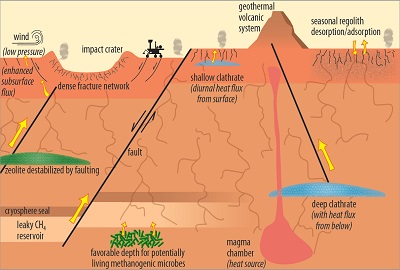
Conceptual diagram illustrating possible methane sources and release mechanisms in the martian subsurface. Features not to scale; spatial relationship between methane sources is designed to show that living biotic sources cannot be shallow. All sources shown, except regolith desorption, can be located at greater depths than those shown.
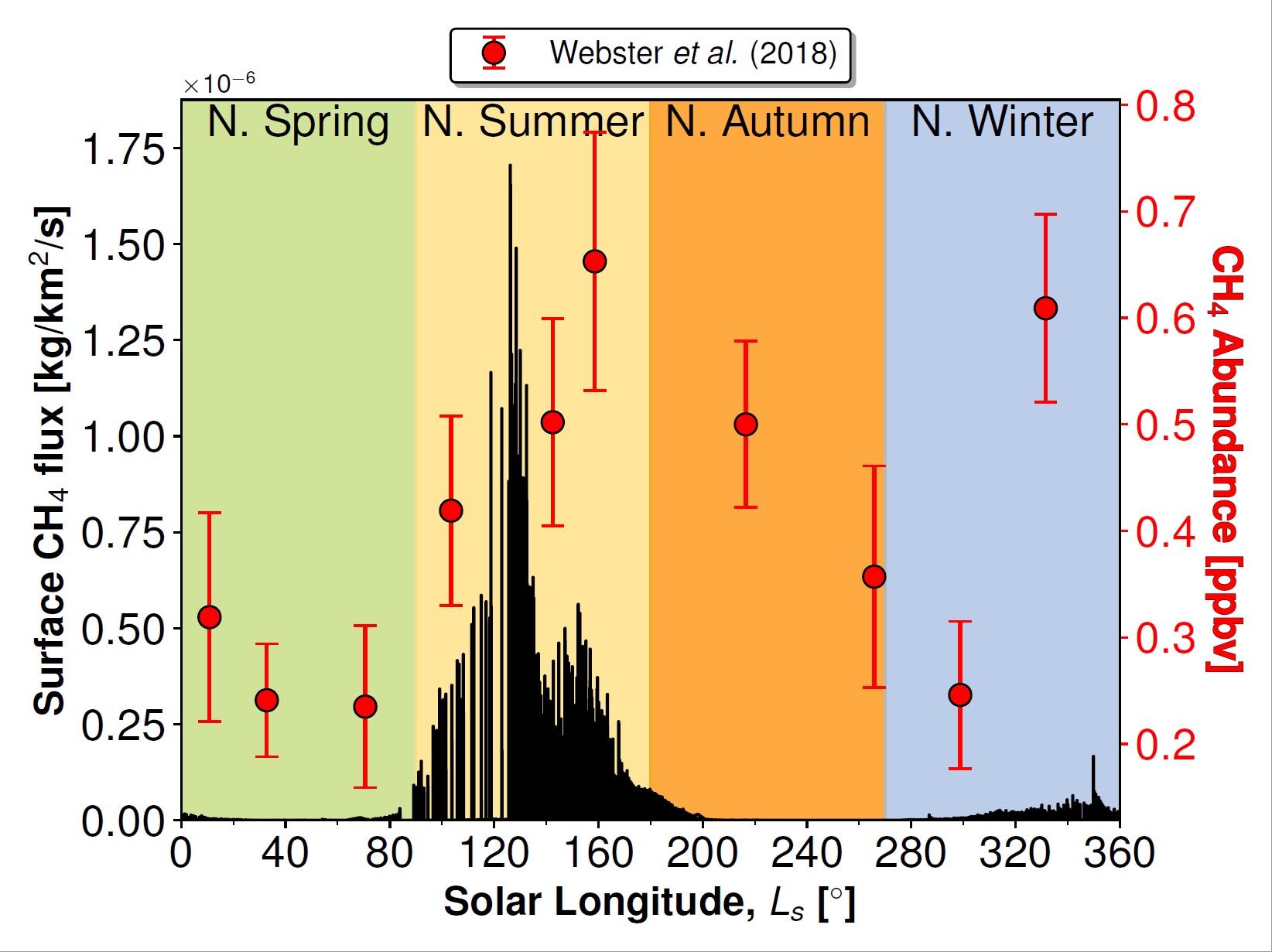
Simulated surface methane flux (black) driven by atmospheric pressure variations plotted against solar longitude (Ls) compared to atmospheric methane concentrations at Gale crater (red circles), which were collected by the Curiosity TLS-SAM instrument suite. Colored zones indicate Mars seasons for the northern hemisphere. The present study found a linear correlation between simulated surface flux and atmospheric methane concentrations, suggesting that the seasonal variations in flux caused by barometric pumping could help explain the seasonality of atmospheric methane abundance.
The existence of methane on Mars is a topic of significant interest because of the possibility the gas is produced by methanogenic microbes – that is, by yet-to-be-discovered life forms. Although evidence strongly suggests that there are active gas sources in the Martian subsurface, the source of the methane and the mechanism for its transmission from the subsurface to the atmosphere are unknown. In new research borne out of a Los Alamos-Johns Hopkins University collaboration and described in a cover story in the journal Geophysical Research Letters, researchers used a numerical flow and transport model to investigate and confirm the viability of a gas transport mechanism capable of efficiently venting methane to Mars’ atmosphere, indirectly reinvigorating support for a microbial source.
Measurements taken by Mars rovers indicate that the concentration of methane in Mars’ atmosphere fluctuates over time. Because of inhospitable conditions near the surface of Mars, methanogenic microbes would have to be located at depths of at least 200 meters. However, nearly all previous models of underground methane transport on Mars have been unable explain the relatively rapid changes in atmospheric concentrations when evaluating a deep methane source, implicitly ruling out biotic sources of methane.
The research team’s model is a modified version of the model normally used for treaty verification related to underground nuclear explosions. In nuclear treaty verification, detecting radionuclide gases seeping at the ground surface over a suspected underground nuclear explosion site provides “smoking gun” evidence of clandestine work. The model builds on work by the Computational Earth Science group (EES-16) performing extensive analysis on barometric pressure variations as a mechanism to drive late-time surface seepage of radionuclides from deep underground tests. Barometric pressure highs at Earth’s surface push gases deeper into fractured rock, while barometric lows pull gases upward. Over multiple cycles, this “barometric pumping” produces a ratcheting mechanism that greatly enhances upward gas transport when rock fractures are present.
The team, including EES-16 members as well as Space and Remote Sensing (ISR-2) group members, investigated whether the same mechanism causing radionuclide seepage on Earth could explain seasonal and short-term atmospheric methane variations on Mars. Adapting the Lab’s Finite-Element Heat and Mass simulator (normally used for treaty verification) to Mars conditions allowed the researchers to determine the effectiveness of the barometric pumping mechanism acting in the Martian subsurface. With Martian atmospheric pressure data gathered by the Curiosity rover as input, Los Alamos researchers simulated methane gas transport from depths of 200 meters to the surface of Mars. Even from a deep source, the model reproduced the seasonality of atmospheric methane observed by Curiosity at Gale crater, and the simulated surface methane fluxes fell within the range of previous estimates derived from atmospheric observations. Because 200 meters is a possible minimum hospitable depth for living methanogenic microbes, the model indirectly reinvigorates the possibility of a microbial source of methane on Mars.
Reference
“Barometric pumping through fractured rock: A mechanism for venting deep methane to Mars’ atmosphere,” Geophysical Research Letters, 49, e2022GL098946 (2022); DOI: 10.1029/2022GL098946. Authors: Ortiz, J. P., Stauffer, P. H., Harp, D. R., Wiens, R. C. (Los Alamos National Laboratory); Lewis, K. W., Rajaram, H. (The Johns Hopkins University).
Funding and mission
This research was supported by the Laboratory Directed Research and Development program. The work supports the Global Security mission area and the Science of Signatures capability pillar.
Technical Contact: John P. Ortiz
New review explores advances and frontiers in fractured rock science
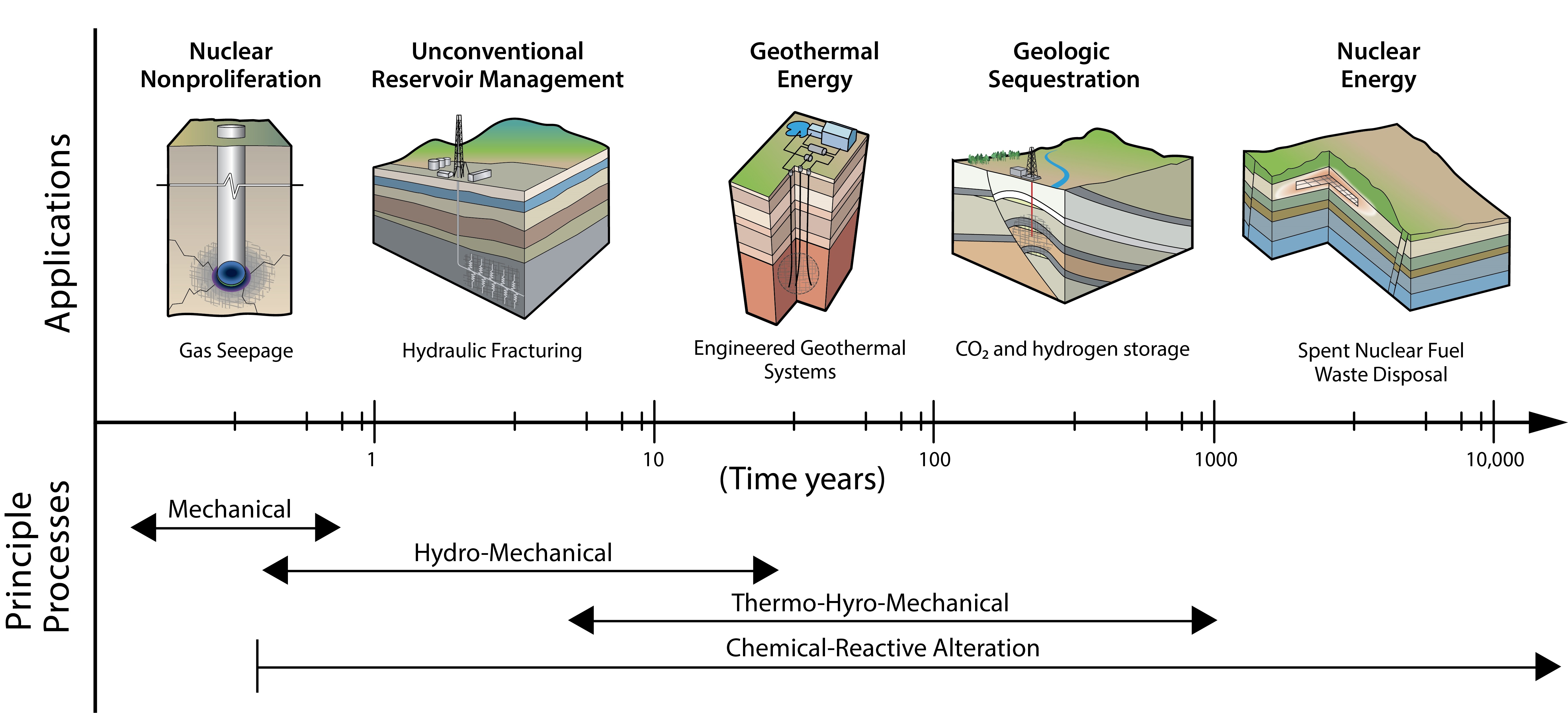
Approximate relevant timescales for subsurface fracture system applications and principle coupled processes that occur from these subsurface activities.
Some of the greatest challenges currently facing humanity have roots in geologic and energy sciences. A common thread in addressing these societal issues with far-reaching economic and environmental impacts is the prediction of flow and transport in systems beneath Earth’s surface, particularly in fractured rock. The need to predict, optimize and ultimately control fractured subsurface systems is an increasingly important topic, with 80% of the U.S energy resources and 50% of its drinking water supply coming from the subsurface. In a recent article in the journal Reviews of Geophysics, a team led by researchers from Los Alamos National Laboratory describe the state-of-the-art research on flow and transport in fracture systems and the path forward for the integration of field observations, laboratory experiments, predictive modeling and uncertainty quantification to enable more efficient and environmentally prudent usage of critical subsurface resources.
The challenges of characterizing fractured systems complicate efforts to optimize many critical subsurface energy production and anthropogenic waste disposal activities. For example, current extraction methods recover little more than 10% of in-place unconventional hydrocarbons, largely believed to be a consequence of sub-optimal fracture performance. Extensive geothermal energy resources remain untapped due to the inability to stimulate and sustain engineered fracture flow effectively. The absence of accurate quantitative predictions of fluid movement and the impact of induced seismicity from deep fluid injection into fracture systems has impeded the development of enhanced geothermal energy and the disposal of produced water and CO2. The viability of CO2 sequestration and high-level nuclear waste disposal remains uncertain because of the difficulty in determining potential flow and transport rates through fractures. Lastly, the emerging area of blue hydrogen, where natural gas is used to produce hydrogen and CO2 is sequestered in the subsurface, is an example of a future energy technology where fractured systems are critical.
With recent advances in field experiments that interrogate fractured systems with much higher fidelity, laboratory experiments that can observe flow, transport, and coupled processes under the high temperature, pressures, and stresses present in the subsurface, and next-generation numerical approaches that take advantage of high-performance computing and machine learning, a new review of the state-of-the-art is needed. The review explores recent advances in new experimental methods, both in the field and in the research laboratory, that provide direct observations of fracture flow; physics-based simulations that span the properties of individual fractures to large complex fracture networks; emulators that can rapidly investigate different fracture property scenarios; and surrogate models that accelerate physics-based models by orders of magnitude to enable uncertainty quantification and near real-time analysis. The authors discuss how these advances have greatly improved understanding and the ability to predict fundamental fracture processes and flow and transport in fractured systems.
Reference
“From fluid flow to coupled processes in fractured rock: recent advances and new frontiers,” Reviews of Geophysics, (2022); DOI: 10.1029/2021RG000744. Authors: Hari Viswanathan, James W. Carey, Jeffrey Hyman, Satish Karra, Gowri Srinivasan (Los Alamos National Laboratory); Jonathon Ajo-Franklin (Rice University); Jens Birkholzer, Yves Guglielmi (Lawrence Berkeley National Laboratory); Laura Pyrak-Nolte (Purdue University); Harihar Rajaram (Johns Hopkins University); Daniel Tartakovsky (Stanford University).
Funding and Mission
This work is supported by the Department of Energy, Office of Science, Office of Basic Energy Sciences’ Geoscience Research Program and the Laboratory’s Laboratory Directed Research and Development program. The work supports the Laboratory’s Energy and Global Security mission areas and its Complex Natural and Engineering Systems capability pillar.
Technical Contact: Hari Viswanathan
Theoretical
ClusterVQE algorithm offers quantum parallel approach for quantum chemistry simulations
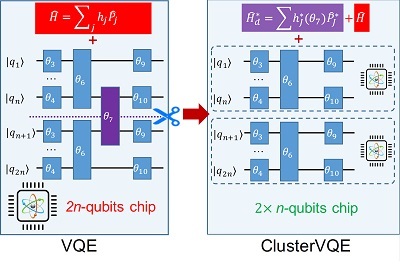
Schematic diagram of ClusterVQE algorithm. To simulate a molecule with 2N spin orbitals, VQE uses a quantum circuit defined on 2N qubits. In contrast, ClusterVQE splits the original 2N-qubit circuit into 2 N-qubit circuits by removing the entanglement between them via a dressed Hamiltonian.
Quantum computers are inherently perfect platforms for simulating molecules, as recognized by Los Alamos National Laboratory researcher Richard Feynman in the 1980s. A flagship algorithm for quantum chemistry, the variational quantum eigensolver (VQE) is one of the most promising algorithms to find eigenstates of a given Hamiltonian on noisy intermediate-scale quantum (NISQ) devices. However, existing NISQ devices have a limited number of qubits and short circuit depth, two significant impediments to applying quantum algorithms like the VQE to realistic molecular systems.
In new research published in the journal npj Quantum Information, researchers from Los Alamos National Laboratory propose a “ClusterVQE” algorithm. The ClusterVQE algorithm divides the simulation of larger molecules into smaller clusters so that each cluster can separately be solved on small quantum devices — the quantum counterpart of classical parallel computation. It is the first time that both circuit depth and circuit width (the number of qubits) are simultaneously reduced.
Simulating molecular properties accurately from the first principles is fundamentally challenging because the computational cost increases factorially against the system size and accuracy. The complexity of quantum circuits imposes limits on their practical realization for problems like molecular simulations. In contrast, quantum computers may significantly reduce computational scaling by leveraging quantum systems as processors. The ClusterVQE algorithm reduces quantum circuit complexity in VQE for electronic structure calculations. The initial qubit space is split into clusters, which are further distributed on individual (shallower) quantum circuits. The clusters are obtained based on mutual information reflecting maximal entanglement between qubits, whereas inter-cluster correlation is taken into account via a new, dressed Hamiltonian. ClusterVQE therefore allows exact simulation of the problem by using fewer qubits and shallower circuit depths at the cost of additional classical resources, making it a potential leader for quantum chemistry simulations on NISQ devices. The research team has presented proof-of-principle demonstrations for several molecular systems based on quantum simulators as well as IBM quantum devices.
The research team’s work provides a practical and quantum parallel scheme for situating large molecules on small quantum devices, which significantly reduces the quantum resource requirements. The ClusterVQE algorithm likely paves the way toward reaching quantum chemistry advantage on NISQ devices.
Funding and mission
The work was supported by the Laboratory Directed Research and Development program. The work supports the Global Security mission area and the Information, Science and Technology capability pillar.
Reference
“Variational Quantum Eigensolver with Reduced Circuit Complexity,” npj Quantum Information, 8, 96 (2022); DOI: 10.1038/s41534-022-00599-z. Authors: Yu Zhang, Lukasz Cincio, Christian F.A. Negre, Piotr Czarnik, Patrick J. Coles, Petr M. Anisimov, Susan M. Mniszewski, Sergei Tretiak and A. Pavel Dub (Los Alamos National Laboratory).
Technical Contact: Yu Zhang (T-1)
Breakthrough accuracy in semi-empirical quantum chemistry via deep learning
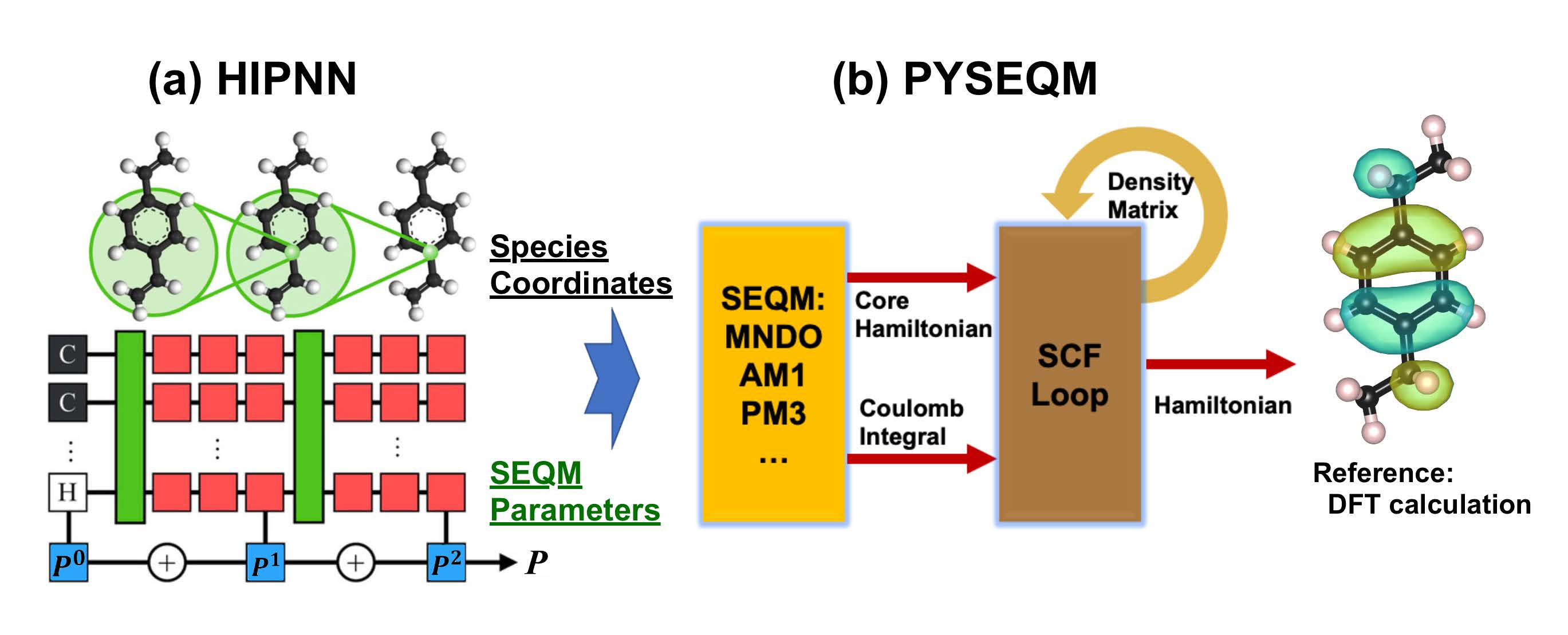
In the HIPNN+SEQM model, the hierarchical interacting-particle neural network passes molecular configuration input features through on-site layers (red blocks) and then shares this information through continuous message-passing layers (green blocks) to generate Hamiltonian parameters based on a molecular configuration. These parameters are used in a semi-empirical Hamiltonian to solve the Schrödinger equation and predict atomic properties.
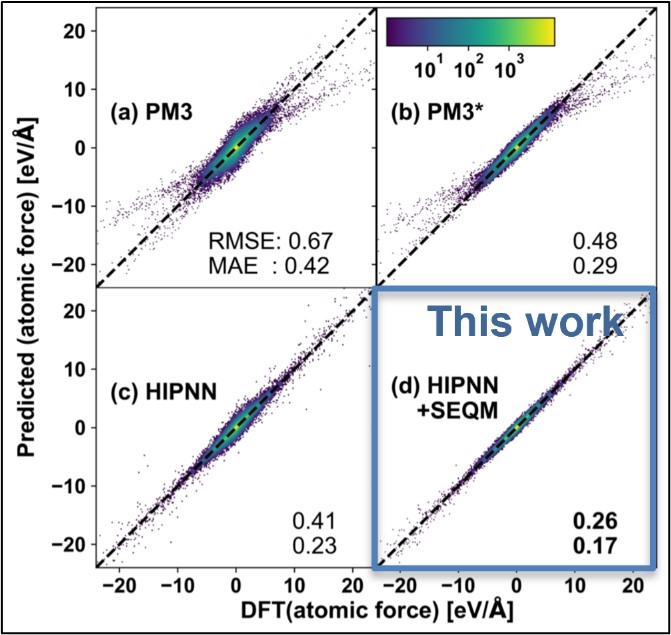
The combined HIPNN+SEQM model (d) makes significantly more accurate predictions than either the pure neural network (c) or SEQM (a, b) models.
Semi-empirical electronic Hamiltonians have nearly 30 years of successful history modeling chemistry processes such as photon absorption and chemical reactivity. However, they have always suffered from limited accuracy and generalizability due to the use of static parameters fit to limited datasets. New research from Los Alamos National Laboratory published in the Proceedings of the National Academy of Sciences uses a machine learning model to dynamically reparametrize semi-empirical Hamiltonians. Allowing physically interpretable model parameters to be adjusted according to the local chemical environment both significantly increases the model accuracy and enables new ways of interpreting results produced by machine learning models. This new paradigm of physics-informed machine learning seeks to revolutionize the way machine learning models are applied to physics problems.
The hierarchical interacting-particle neural network, or HIPNN architecture, is a message-passing neural network for use on atomistic systems. HIPNN takes the molecular configuration as input, where each molecule is represented as a set of atom types and positions. The input features are passed through on-site layers, which are applied to the local features for each individual atom. Then this information is shared through continuous message-passing layers, which pass information between nearby atoms and allow atoms to see their chemical environments. An inference layer is applied to the output from each of the last on-site layers to obtain zero- to higher-order corrections of Parametric Method 3 Hamiltonian parameters.
The Hamiltonian parameters are fed into the semi-empirical quantum mechanics (SEQM) module, which uses the self-consistent field procedure to solve the motion of electrons in the current molecular configuration. The solution of this problem provides full quantum information including wavefunctions, charge distributions, molecular energy and atomic forces. The properties predicted by the combined HIPNN+SEQM model generally outperform both traditional SEQM and neural network results. This new type of machine learning model will facilitate the accurate solution of complex electronic structure problems, such as excited state and open shell systems.
This work represents a significant development in both machine learning models and semi-empirical quantum mechanics. While most machine learning models are “black box” methods, the HIPNN+SEQM model provides additional physical insight through the parameters predicted by the neural network. Interestingly, the neural network assigns different values to atomic Hamiltonian parameters based on traditional views of atomic bonding. If an atom forms a triple bond with a neighbor, it has a significantly different p-orbital energy parameter than if it forms a double or only single bonds.
This new class of machine learning enhanced semi-empirical quantum mechanics models will enable increasingly accurate theoretical studies of chemical reactivity, photo-absorption, excited state dynamics, polaritonics and other related phenomena. These applications are critical to the Los Alamos National Laboratory mission, either through the simulation of reactive molecules or simulating future organic photovoltaic systems critical to national energy security.
Funding and mission
This work was funded by the Laboratory Directed Research and Development program and supports the Energy Security mission area and the Materials for the Future capability pillar.
Reference
“Deep learning of dynamically responsive chemical Hamiltonians with semiempirical quantum mechanics,” Proceedings of the National Academy of Sciences, 119, 27, e2120333119 (2022); DOI: 10.1073/pnas.2120333119. Authors: Guoqing Zhou, Nicholas Lubbers, Kipton Barros, Sergei Tretiak and Benjamin Nebgen (Los Alamos National Laboratory).
Technical Contacts: Benjamin Nebgen, Kipton Barros, Sergei Tretiak (T-1)


